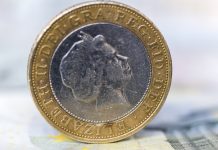The pound charged higher against the dollar early on Monday. However, it was unable to hold on the gains. In the US session, the dollar moved higher, pulling the pound US dollar exchange rate lower. The rate finished the day at US$1.3220 for the pound, after falling from an 8-week high hit earlier in the session.
| What do these figures mean? |
|---|
|
When measuring the value of a pair of currencies, one set equals 1 unit and the other shows the current equivalent. As the market moves, the amount will vary from minute to minute. For example, it could be written: 1 GBP = 1.28934 USD Here, £1 is equivalent to approximately $1.29. This specifically measures the pound’s worth against the dollar. If the US dollar amount increases in this pairing, it’s positive for the pound. Or, if you were looking at it the other way around: 1 USD = 0.77786 GBP In this example, $1 is equivalent to approximately £0.78. This measures the US dollar’s worth versus the British pound. If the sterling number gets larger, it’s good news for the dollar. |
The pound was broadly stronger in the previous session, although less so than the dollar. Sterling pushed high after the UK government revealed its new industrial strategy, which aims to improve productivity in the UK and boost economic growth. The government is wanting to strengthen the UK economy before leaving the EU; the strategy seems to be to create a financial safety net for the economy before Brexit.
In a white paper, the government laid out its plans to target four key areas: construction, life sciences, artificial intelligence and automotives. Investment is to be an important part of the strategy and two large pharmaceuticals have already signed up as investors. Increased investment and more jobs is a win-win for the UK economy. However, some critics of the strategy suggest that it lacks excitement and is therefore inadequate in attracting the investment it expects to attract. The pound therefore had a tepid response to the strategy in an otherwise quiet day.
After a quiet Monday, the week is set to begin today. The Bank of England (BoE) will release its Financial stability report which could inject some volatility in the currency. The report looks into the health of the UK economy and also provides future guidance to expected financial stability. Investors will be listening carefully to the tone that the central bank strikes. A degree of caution could be expected due to the uncertainties of Brexit. However, a very cautious tone pointing to a weak economic outlook could unnerve investors and send the pound lower.
| Why does poor economic outlook drag on a country’s currency? |
|---|
| Slowing economic indicators point to a slowing economy. Weak economies have weaker currencies because institutions look to reduce investments in countries where growth prospects are low and then transfer money to countries with higher growth prospects. These institutions sell out of their investment and the local currency, thus increasing supply of the currency and pushing down the money’s worth. So, when a country or region has poor economic news, the value of the currency tends to fall. |
The Dollar Finally Rises Following Strong Economic Data
The dollar enjoyed a rare show of strength on Monday, as strong US economic data and aggressive comments by the US Federal Reserve comments sent the dollar rate higher. Firstly, data showed that the sales of new single-family houses in October hit its highest level in 10 years. This is important because it paints the picture of a strong economy and a confident consumer. As a result, the dollar gained ground.
Secondly, Federal Reserve official Robert Kaplan made some hawkish comments in a speech on Monday, which also boosted the dollar. The Dallas Fed President pointed out that waiting for inflation to move higher could mean that the Fed then “falls behind the curve”. This would mean the Fed may need to raise rates faster. Following the remarks, investors increased their expectations for rate rises in 2018, which pushed the dollar higher.
| Why do raised interest rates boost a currency’s value? |
|---|
| Interest rates are key to understanding exchange rate movements. Those who have large sums of money to invest want the highest return on their investments. Higher interest rate environments tend to offer higher yields. So, if the interest rate or at least the interest rate expectation of a country is relatively higher compared to another, then it attracts more foreign capital investment. Large corporations and investors need local currency to invest. More local currency used then boosts the demand of that currency, pushing the value higher. |
|
This article was initially published on TransferWise.com from the same author. The content at Currency Live is the sole opinion of the authors and in no way reflects the views of TransferWise Inc. |





